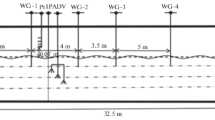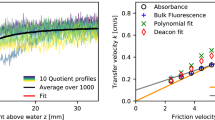Abstract
Most environmentally important gases (such as oxygen or carbon dioxide) have low solubility. The transfer process of such gases across the air–water interface is controlled by molecular diffusion and turbulence, concentrated within a very thin layer in the water side. A challenge for a better understanding of the problem is to be able to elucidate the transport processes happening within this thin layer. We used non-invasive measurement techniques to study the interaction between the gas transfer process and the hydrodynamic condition in the water phase with two different turbulence forcing mechanisms, namely grid-stirred and buoyant-convective turbulence. The experimental setup for the turbulence generation and the measurement techniques are described. The different dominating turbulent transport mechanisms of the two cases were discussed, and a comparison of the different measured scales between the two cases is also presented.







Similar content being viewed by others
References
Churchill MA (1961) Effect of water temperature on stream reaeration. J Sanit Eng Div 5(87):59–71
Danckwerts PV (1951) Significance of liquid-film coefficients in gas absorption. Ind Eng Chem 43:1460–1467
Deadorff JW (1970) Convective velocity and temperature scales for the unstable planetary boundary layer and for Raleigh convection. J Atmos Sci 27:1211–1213
Herlina, Jirka GH (2004) Application of LIF to investigate gas transfer near the air–water interface in a grid-stirred tank. Exp Fluids 37(3):341–349
Herlina, Jirka GH (2008) Experiments on gas transfer at the air–water interface induced by oscillating grid turbulence. J Fluid Mech 59:183–208
Higbie R (1935) The rate of absorption of a pure gas into a still liquid during short periods of exposure. AIChE Trans 31:365–390
Hopfinger EJ, Toly JA (1976) Spatially decaying turbulence and its relation to mixing across density interfaces. J Fluid Mech 78:155–175
Imboden DM, Wüest A (1995) Mixing mechanisms in lakes. In: Lerman A, Imboden DM, Gat JR (eds) Physics and chemistry of lakes. Springer, Heidelberg, pp 83–138
Jähne B (1980) Zur Parametrisierung des Gasaustausches mit Hilfe von Laborexperimenten. PhD Dissertation, University of Heidelberg
Jähne B et al (1984) Wind/wave-tunnel experiment on the schmidt number and wave field dependence of air–water gas exchange. Gas Transfer at Water Surfaces 1st International Symposium Ithaca Reidel Publishing Company
Kermani A, Shen L (2009) Surface age of surface renewal in turbulent interfacial transport. Geophys Res Lett 36:L10605
Komori S, Nagosa YM (1993) Turbulence structure and mass transfer across a sheared air–water interface in wind driven turbulence. J Fluid Mech 249:161–183
Lewis WK, Whitman WG (1924) Principles of gas absorption. Ind Eng Chem 16:1215–1220
Magnaudet J, Calmet I (2006) Turbulent mass transfer through a flat shear-free surface. J Fluid Mech 553:155–185
McKenna SP, McGillis WR (2002) Surface divergence and air–water gas transfer. In: Donelan MA, Drennan WM, Saltzman ES, Wanninkhof R (eds) Gas transfer at water surfaces. AGU geophysical monograph series, vol 127. AGU Press, pp 129–134
McKenna SP, McGillis WR (2004) The role of free-surface turbulence and surfactants in air–water gas transfer. Int J Heat Mass Transf 47:539–553
Moog DB, Jirka GH (2002) Air–water gas transfer in uniform flows with large gravel-bed roughness. In: Donelan MA, Drennan WM, Saltzman ES, Wanninkhof R (eds) Gas transfer at water surface. AGU geophysical monograph series, vol 127. AGU Press, pp 371–376
Münsterer T, Mayer HJ, Jähne B (1995) Dual-tracer measurements of concentration profiles in the aqueous mass boundary layer. Air–water gas transfer. In: 3rd international symposium on air–water gas transfer, pp 637–648
Nezu I, Nakagawa H (1993) Turbulence in open channel flows. Balkema, Rotterdam
O’Connor DJ, Dobbins WE (1956) The mechanism of reaeration in natural streams. J San Eng 82(SA6):1115–1140
Pan Y, Banerjee S (1995) A numerical study of free surface turbulence in channel flow. Phys Fluids 7:1649–1664
Plate EJ, Friedrich R (1984) Reaeration of open channel flow. In: Brutsaert W, Jirka GH (eds) Gas transfer water surfaces. D. Reidel Publishing, pp 333–346
Roy AG, Buffin-Bélanger T, Lamarre H, Kirkbride AD (2004) Size, shape and dynamics of large-scale turbulent flow structures in a gravel-bed river. J Fluid Mech 500:1–27
Schladow SG, Lee M, Hürzeler BE, Kelly PB (2002) Oxygen transfer across the air–water interface by natural convection in lakes. Limnol Oceanogr 47(5):1394–1404
Sugihara Y, TsumorIi H (2005) Surface-renewal eddies at the air–water interface in oscillating-grid turbulence. In: Lee, Lam (eds) Proceedings of environmental hydraulics and sustainable management. Taylor & Francis Group, London, pp 199–205
Tamburrino A, Gulliver JS (2002) Free-surface turbulence and mass transfer in a channel flow. AIChE J 48(12):2732–2743
Thackston EL, Krenkel PA (1969) Reaeration prediction in natural streams. J Sanit Eng Div Proc ASCE 95(SA1):65–93
Theofanus TG (1984) Conceptual models of gas exchange. In: Brutsaert W, Jirka GH (eds) Gas transfer at water surfaces. D. Reidel Publishing, pp 271–281
Vaughan WM, Weber G (1970) Oxygen quenching of pyrenebutyric acid fluorescence in water, a dynamic probe of the microenvironment. Biochemistry 9:464–473
Wolff LM, Hanratty TJ (1994) Instantaneous concentration profiles of oxygen accompanying absorption in a stratified flow. Exp Fluids 16:385–392
Woodrow PT, Duke SR (2002) LIF measurements of oxygen concentration gradients along flat and wavy air–water interfaces. Geophysical Monograph 127, Gas Transfer at Water Surfaces, pp 83–88
Acknowledgments
The project was funded by the “German Science Foundation” (DFG Grant No. Ji18/7-1, Ji18/7-2, Ji18/13-1, and He5609/1-1).
Author information
Authors and Affiliations
Corresponding author
Rights and permissions
About this article
Cite this article
Jirka, G.H., Herlina, H. & Niepelt, A. Gas transfer at the air–water interface: experiments with different turbulence forcing mechanisms. Exp Fluids 49, 319–327 (2010). https://doi.org/10.1007/s00348-010-0874-4
Received:
Revised:
Accepted:
Published:
Issue Date:
DOI: https://doi.org/10.1007/s00348-010-0874-4




